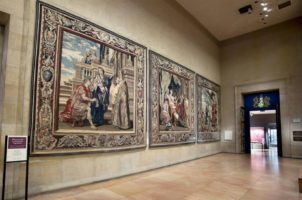
Constantine in Threads
On this episode of 5 Minutes in Church History, Dr. Stephen Nichols returns to the Philadelphia Museum of Art and walks us through a series of tapestries depicting Constantine’s life.
At the center of Philadelphia Museum of Art is the Great Stair Hall, which is surrounded by a large and impressive balcony. Even more impressive is what lines the walls of that balcony: a series of tapestries, twelve in all, known as the Constantine Tapestries. These tapestries were the result of the work of two Baroque painters, Peter Paul Rubens and Pietro da Cortona. Cortona was an Italian Baroque painter, while Rubens was a Flemish master—perhaps the Flemish master in the Baroque style. He was born in Germany, but from the age of ten, he lived in Antwerp, Belgium. These tapestries were originally done for King Louis XIII of France. They were commissioned by a bishop from the house of Barberini who owned a tapestry factory. Initially, he commissioned Rubens to do these tapestries, and Cortona contributed later designs.
 For inspiration, Rubens turned to a book by Eusebius, the early church historian. Eusebius’ major historical work was Ecclesiastical History, which tells the story of the early church. He also wrote The Life of Constantine. Constantine the Great was the Roman emperor who granted Christianity legal status in the Roman Empire.
For inspiration, Rubens turned to a book by Eusebius, the early church historian. Eusebius’ major historical work was Ecclesiastical History, which tells the story of the early church. He also wrote The Life of Constantine. Constantine the Great was the Roman emperor who granted Christianity legal status in the Roman Empire.
A number of the tapestries in the Philadelphia Museum of Art tell the story of the life of Constantine. One depicts his marriage to Fausta. Another depicts his triumphal entry into Rome as a general. One depicts his baptism. Another depicts his death. One depicts Constantine’s directing the building of the city of Constantinople. Another depicts his mother, Helen, who was a very pious woman, helping him learn how to worship. In this tapestry, Constantine is kneeling with a bishop holding a cross, and she is looking at him and pointing to the cross.
One of the tapestries depicts one of the most important scenes of Constantine’s life: the Battle of Milvian Bridge. It was just before the Battle of Milvian Bridge that Constantine is said to have seen a vision and heard the words, “By this sign, you will have victory.” In hoc signo vinces. The sign was the Chi-Rho. The letters chi and rho are the first letters of Christ in Greek. In the border of all these tapestries, at the top center, is that symbol, the Chi-Rho.
Another of the tapestries depicts Constantine’s ordering the destruction of pagan idols. Before Constantine, Rome was a pagan nation-state where Christians were persecuted. After the Battle of Milvian Bridge and Constantine’s professed conversion to Christianity, he attempted to rid Rome of its pagan idols. Constantine took measures to advance the Christian church during his reign. One of the tapestries depicts an interesting moment when Constantine gave tax concessions to the Christian church. To this day, many churches and religious institution are free from paying property tax. That came from Constantine, and it’s depicted in one of the Constantine Tapestries. These are the threads that tell the story of the life of Constantine, lining the walls of the balcony of the Great Stair Hall of the Philadelphia Museum of Art.
Stay connected with 5 Minutes in Church History by getting the weekly podcast on iTunes, SoundCloud, or via RSS. You can also subscribe to the blog via RSS and follow us on Twitter and Facebook.
(This podcast is by Ligonier Ministries. Discovered by Christian Podcast Central and our community — copyright is owned by the publisher, not Christian Podcast Central, and audio is streamed directly from their servers.)